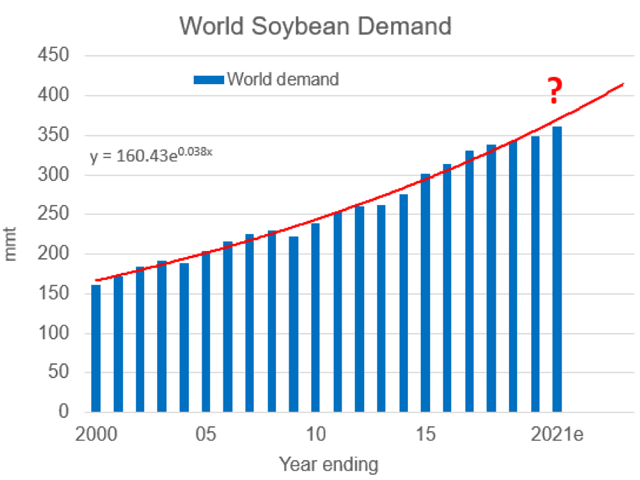Todd's Take
A Closer Look at Soybean Demand
On Thursday, USDA released its latest supply and demand estimates for June, and as expected, most of the changes were minor tweaks. A 50 million bushel (mb) reduction in ethanol demand for corn and a 25 mb cut in soybean exports showed up, as expected.
The slightly bullish surprise of the day was a lower-than-expected 395 mb estimate of U.S. ending soybean stocks for 2020-21. As mentioned above, USDA cut its old-crop soybean export estimate but also increased the crush demand estimates for both, old-crop and new-crop soybean by 15 mb each. Given the current demand struggles in the wake of the coronavirus, the crush increases were slightly impressive for soybean demand.
Most understand why corn's large new-crop ending stocks estimate of 3.32 billion bushels (bb) is bearish for corn prices. In soybeans, however, we have a different situation where a 395 mb ending stocks estimate would typically warrant an average cash price near $10 a bushel, much higher than the $8.21 a bushel DTN's National Soybean Index closed at on Thursday, June 11.
Part of the reason soybeans aren't trading near $10 is due to the current nervousness of the coronavirus situation. Anxieties are easing, but economies around the world have taken big hits and investors are in no mood to get overly bullish about anything.
Another reason soybeans aren't trading higher is due to the uncertainty of trade relations with China. U.S. exports have picked up lately, but public conversations between the U.S. and China are as contentious as ever, stoked by China's latest move in Hong Kong. Understandably, traders are reluctant to trust USDA's demand estimates.
Current conditions favor more U.S. export business ahead, as Brazil's FOB soybean prices for August are near their highest level in five months and 41 cents above comparable prices at the U.S. Gulf. Here in June, it looks like Brazil's soybean supplies are tightening, and the export pendulum has swung back toward the U.S. So far, China has not been so upset that they refuse U.S. soybeans priced to their advantage.
In the bigger picture, it is interesting that USDA increased its estimate of 2020-21 world soybean demand from 361 million metric tons (mmt) to a record high 362 mmt (13.30 billion bushel). The new estimate is a 3.8% increase from the prior year, which also happens to be the pace of trend-line growth for world soybean demand since 2000.
P[L1] D[0x0] M[300x250] OOP[F] ADUNIT[] T[]
The International Grains Council (IGC) has a similar estimate for world new-crop soybean demand of 353 mmt, a 2.5% increase from the previous year, according to their books.
Both USDA and the International Grains Council (IGC) are starting with what appear to be safe, traditional demand forecasts, but estimating demand is a difficult process 14 months before the end of the new season, and surprises can happen.
On May 28, the United Nations Conference on Trade and Development (UNCTAD) issued a study that was largely bearish for commodities in 2020, expecting a drop of up to 46% in global exports as a result of the coronavirus pandemic.
Soybeans, however, were one of the bullish exceptions and the study expects China's soybean imports to be up 34% in 2020. Yes, a whopping 34%! Let me quickly say that I do not expect China's soybean imports to be up 34% in 2020, but I will admit to bullish suspicions about China's buying patterns this year.
UNCTAD may have a point.
I say that because China's overall soybean imports have been down ever since the trade dispute with the U.S. started in 2018. Part of China's strategy to weather the storm of U.S. tariff threats has been to buy all the South American soybeans they could get. The other part has been to limit their own consumption.
Even after fighting through African swine fever and surviving the coronavirus, China has shown a strong appetite for soybeans in 2020, and it could be a case of pent-up demand after two years of belt-tightening. As mentioned above, Brazil's supplies already appear to be dwindling.
Just for kicks, what would it look like if China's soybean imports increase 10% in 2020-21 instead of USDA's estimated 2% increase?
That scenario adds 7.4 mmt or 272 mb of new export business. USDA already estimates Brazil ending soybean stocks at just 114 mb on Jan. 31, 2021, so there isn't room for Brazil to participate and Argentina has a 33% export tax in the way.
That leaves the door open for the U.S. to benefit from higher-than-expected demand from China, should it happen. Even if the result of increased demand was to make USDA's 395 mb ending stocks estimate come true in 2020-21, it would be bullish for prices, making a stronger case for $10 cash soybeans.
Discussing demand scenarios before the new-crop season has even begun is always a difficult exercise, and we have a lot to learn about the new season ahead. Coronavirus and the trade dispute with China are two strong headwinds for soybean prices, but it is also impressive how the weekly chart of July soybeans recently showed a bullish change in price momentum.
USDA's world estimate of 3.8% demand growth in 2020-21 is a safe and traditional way to start the season, but we'll keep monitoring market clues, just in case UNCTAD is on to something.
Click on this link to read the UNCTAD study: https://unctad.org/…
Todd Hultman can be reached at Todd.Hultman@dtn.com
Follow him on Twitter @ToddHultman
(c) Copyright 2020 DTN, LLC. All rights reserved.




